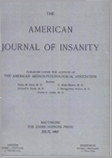RELATIONSHIP BETWEEN THE CEREBROSPINAL FLUID SUGAR AND BLOOD SUGAR IN UNTREATED NEUROSYPHILIS
Abstract
A study of the simultaneous fasting cerebrospinal fluid sugar and blood sugar in untreated neurosyphilis is presented.
The cerebrospinal fluid sugar was within normal range in 88.2 per cent of the cases and the blood sugar in 89.2 per cent.
The ratio existing between the cerebrospinal fluid sugar and the blood sugar was within the normal range in only 51.2 per cent of the cases of neurosyphilis: 51.5 per cent of the cases of general paresis, 55 per cent of the cases of cerebrospinal syphilis with psychosis, and in 41.7 per cent of the cases of tabes without psychosis.
This ratio was below normal in 13.2 per cent of the cases of neurosyphilis: 12.7 per cent of the cases of general paresis, 15.0 per cent of the cases of cerebrospinal syphilis with psychosis, and 16.6 per cent of the cases of tabes without psychosis.
And the ratio was above normal in 35.6 per cent of the cases of neurosyphilis: 35.8 per cent of the cases of general paresis, 30.0 per cent of the cases of cerebrospinal syphilis with psychosis, and 41.7 per cent of the cases of tabes without psychosis.
Therefore, in 48.8 per cent of the cases of untreated neurosyphilis there is definite evidence of some abnormality in the hemato-encephalic barrier to the passage of sugar.
Access content
To read the fulltext, please use one of the options below to sign in or purchase access.- Personal login
- Institutional Login
- Sign in via OpenAthens
- Register for access
-
Please login/register if you wish to pair your device and check access availability.
Not a subscriber?
PsychiatryOnline subscription options offer access to the DSM-5 library, books, journals, CME, and patient resources. This all-in-one virtual library provides psychiatrists and mental health professionals with key resources for diagnosis, treatment, research, and professional development.
Need more help? PsychiatryOnline Customer Service may be reached by emailing [email protected] or by calling 800-368-5777 (in the U.S.) or 703-907-7322 (outside the U.S.).



